English-version page
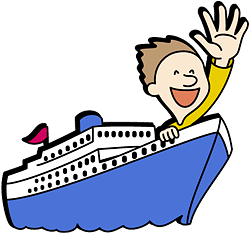
(click here→)To the Japanese-version page (click here→) To the Top-page
(click here→)To the members 観光マップ(map) See top-page for announcement,
especially, to guests. 観光album(sightsee)
https://qwvhw.crayonsite.info へのリンク
JapanQ&A/Bell ! WHITE企画(WHITE office)
English-version page
![]()
![]() last update : June the 18th, 2020
last update : June the 18th, 2020 ![]()
![]()

(click here→)To the Japanese-version page (click here→) To the Top-page
(click here→)To the members 観光マップ(map) See top-page for announcement,
especially, to guests. 観光album(sightsee)
https://qwvhw.crayonsite.info へのリンク
| For tourists from abroad |
I AM A NATIONAL LICENSED GUIDE_INTERPRETER. Gender : man
Name : Tadashi Nakamae <通訳案内士 & Domestic travel service supervisor & social welfare and care
manager / ex-bank clerk & teacher>
TELEPHONE: 08083132688 [from Japan (domestic call)] for urgent need during our trip
pandannn8@gmail.com
| MY GUIDE SPOT / ALL JAPAN WELCOME TO JAPAN |
Consist of 4 large islands, Hokkaido in north part, Honshuu,main island from north and east to west part, Shikoku in west part,
Kyushuu in west part.
※ JAPAN has four clear-cut seasons with a rainy season, spring , summer, autumn, winter.
The Japanese climate is influenced by geographical location,summer and
winter monsoon, ocean currents and topography.
RECOMMENDABLE SPOT : KINKI district<近畿> in Kansai (関西) Area- Osaka(Sakai,Izumisano,Osaka),Kyoto,Nara,
Hyougo pref.(Kobe,Himeji), Mie pref.(Ise,Shima), Shiga pref.(Hikone, Biwako Ohashi, which means a long bridge),
Wakayama pref. (Wakayama,Arida, Hashimoto,Katsuragi ) →KYUSHUU<九州>( Okinawa,etc.),
CHUUGOKU<中国>(Hiroshima,Okayama etc), SHIKOKU<四国>(Ehime,Kagawa,etc),
CHUUBU<中部>「(Aichi,Gifu,etc.) +
HOKURIKU<北陸>(Ishikawa,Toyama,etc)」,KANTOU< 関東>(Tokyo,Kanagawa,etc), TOUHOKU<東北>(Miyagi,Aomori,etc),
HOKKAIDOU<北海道>(Hokkaido)
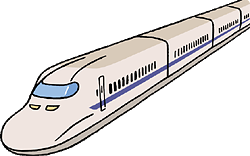 ☆FARE<from city to city> LEVEL1 (ONE WAY) ; WITHIN 5000YEN , LEVEL2
; OVER 5000YEN TO 10000YEN
☆FARE<from city to city> LEVEL1 (ONE WAY) ; WITHIN 5000YEN , LEVEL2
; OVER 5000YEN TO 10000YEN
LEVEL 3 ; OVER 10000YEN TO 15000YEN , LEVEL 4 ; OVER 15000YEN
¶ Transportations (By train) LEVEL1 ; Osaka City-1or1.5HOURS-Kobe City/ Osaka City-1or1.5HOURS-Kyoto City
Osaka City-1or1.5HOURS-Nara City / Osaka City-1or1.5HOURS-Wakayama City/ others-Ask me,please.
※From City or outside To City or outside in detail ; It depends on places(ex. Ward, Town or county)
¶ Transportations (By train)LEVEL2or3(or4) ; Osaka City- about 3HOURS-Tokyo.>> Ask me in detail, please.
¶ Transportations (By train or others) ; Osaka City- Your destinations (other regions or areas) >> Ask me in detail, please.
Contact/also available : pandannn8@gmail.com
○ MY MESSAGE TO TOURIST GUESTS FROM ABROAD :
First, contact me by e-mail, please. So, I can research some information you want to
get by using my smart-phone,PC, or others and inquiring it of persons concerned on the telephone.
However, it might be not guaranteed according to other circumstances.
If research fee is for a travel plan you propose to me, it is free of charge.
※ If you request planning for your optional trip, planning fee is needed.
However, planning fee is not needed for regular plans I suggest on this English version page,
and also a simple plan which hardly needs detailed research.
※※ Consult Japan Q&A/Bell! WHITE office on your plan in detail, please. Thank you !
※Transportations (By taxi) especially rural area, bus inconvenient area,outskirts
or late time, let's use taxi service positively.
☆☆Let's go to any tourist spot you have requested such as Tokyo, Okinawa and other attractive places.
☆Welcome your own optional tour for something ,such as watching sumo matches
and puppet play and going to sports studium.
☆ The most recommendable spot / Wakayama(esp. Koyasan<高野山>famous
for temples)
Plus ; Kumano Kodo <熊野古道>for the ancient pilgrimage track [ road
]
★GUIDE FEE/ HALF DAY<4HR>15000YEN , FULL DAY<8HR>30000YEN including meal time, plus other fees depending on time
zone etc. ※FEE(RATES) including tax
※ In particular or special cases, you might get some discount and special
itenerary for travel situation by using certain
member's cards I have. I would put them on this web regarding the specific
contents.
※One hour unit will be needed for hiring the guide.
If we can not have meal time during our trip, charge is 30000yen for 7hours
: for 8 hour guided tour, the charge would be
30000yen for 7 hours plus additional fee (overtime fee 5000yen). Because 1hour for meal time exclusive is a kind of
free time. Total ; 35000 yen for guide fee in this case. Therefore, total all inclusive is 39000yen including meal charge for lunch
and dinner (in this case, you have to pay 4000yen for lunch and dinner
)
Apart from GUIDE FEE :
You need to pay your own entrance fee to each facility&transpotation
expenses of a guide.
According to the places, you have to pay my entrance fee for tourist facilities,
but some places might not be required
to pay the entrance fee of a guide. Besides if you have meal with me,
you need to pay for my meals.
(if you don't have meal with me,you need to pay fixed amount for my meals)
☆ 1500yen~2000yen for breakfast, which is needed when Guide stays overnight
on our itinerary.
1500yen~2000yen for lunch, which is needed when you keep Guide for full
day.
1500yen~2000yen for dinner, which is needed when you keep Guide for overnight
stay and over 8 hours.
New ! ☆☆SPECIAL SETTING PRICE FOR MEALS (for instance, Koyasan area, etc.)
Japan is higher prices for foods as well than other countries.
It is set on a higher price paid to your guide for each meal, otherwise
in some areas, it offers us a lower price for meal,
therefore, if it is an appropriate amount of food to have each meal, it
is OK to pay 50 percent off the setting price above.
please tell me about that.
<☆first sentence and third sentence items updates/ May 18, 2017>
<ADDED ☆☆ items updates/ April 22, 2018>
※ Ideal trip mindset to keep our trip comfortable and healthy is-
Let's have meals(1500~ 2000yen each) on a good timing within fixed tour
hours as perfectly as possible.
☆☆☆ If you make an itinerary with an overnight stay, you need to pay for my
accommodations.
Accommodations(LODGINGS)charges have to be paid when my duty hours will be over 11pm. or set by our special
contract.
Also,accommodations (LODGINGS) charges have to be paid when you and guide have
to stay there or near there
at night in a transport-inconvenient area. In this case, we utilize taxi services to get lodgings and spots you want.
☆☆☆☆ Time zone to hire translator or Guide-interpreter
If you would like to hire Guide earlier than 8a.m. , you need to pay overtime
fee 5000yen per hour
(basic fee 3750 yen per hour and extra fee 1250yen) .
If you would like to hire Guide over 8 hours, or over 11p.m., you need
to pay overtime fee 5000yen per hour.
(basic fee 3750 yen per hour and extra fee 1250yen) .
| contact |
WEB ; http://www.roy.hi-ho.ne.jp/tanuki/
※ E-mail;panda_1278hij@yahoo.co.jp
* If it is inconvenient to you from the top page,
you can directly use the mail-adress below.
E-mail ;
pandannn8@gmail.com
When you mail me (JapanQ&A/Bell! WHITE office), please see and check
the article below,
![]()
![]() Submit the confirmation items for application(The bottom of this page).
Submit the confirmation items for application(The bottom of this page).
And you can also make inquiries about other matters.
◎When accessing to this web next time , you just might put into" Japan Q&A "OR "Hi-Ho Japan Q&A" OR" JapanQ&A
TadashiNakamae "OR "Japan Q&A WHITE 企画 旅".
☆ Telephone is surely OK. But when you tell it in detail, probably e-mail
is easier.
| How to pay basic fees ~ |
☆ You can pay guide fees and other fees at the meeting places
except transpotation fees and indefinite fees before performing our plan for the tour or other duties.
☆ You can also pay guide fees and other definite fees before coming to
Japan,
utilizing money transfer-system of the universal postal bank institution.
If it is possible, I would tell you about my postal bank account on the
internet
when we make a travel plan by way of the Email or others.
☆ On the other hand, I would like you to pay at each place directly each
cost,
such as buying tickets,lodging, and so on. I will politely tell how
to pay them there.
Otherwise, If we can make a special contract according to the situation,
let's use some convenient way.
☆ However, how to pay depends on situations and the contract you have requested.
Let's talk about it in detail on line.
| cancellation fee |
☆ When an order is cancelled, a cancellation fee will be charged as follows.
(1) No advance notice or notice on the day ⇒ 100% of the fee
(2) 1-2days in advance ⇒ 80% of the fee
(3) 3-7days in advance ⇒ 30% of the fee
※※ The same fee for up to three people/ up to 5 people over 3: additional
fee 5000yen
per person for a full day
○EX. In case of five people for full day: basic fee 30000 yen(if half day,15000)
+ additional fee 10000 yen
(if half day, 2500yen per person./two people added: 5000 yen)=40000 yen(if
half day 20000yen) //
baby,infant,pre-school child,young child : no charge ///over age 5, less
than 13 : half price for additional fee.
NEW (since 2018)
plus, this office will start a new business as land operator soon.
Land Operator means travel service arrangers.
This business takes on requests from travel agents.
↓
☆ Contents of service operation (1~4 etc.)
1 accommodations arrangement 2 guide arrangement for tourists
3 transportations arrangement 4 other arrangements
National Travel Law, The Article 25th.etc,
Authorized over Japan by Wakayama Governor.
※ Please propose by way of E-mail.
![]() Do you know Japanese currency?
Do you know Japanese currency?
Coin:one-yen, five-yen, ten-yen, one-hundred yen, five-hundred yen(very
big size)
Bill: one thousand-yen, two thousand-yen, five thousand-yen, ten thousand-yen
※ ten-yen × 10 pieces = 100 yen
<Service A> Pick-up Service and Lower priced accomodations Info.Plan
| ¶ PICK-UP SERVICE only/ [At Kansai Airport, Itami Airport,etc.in Kansai] I
can pick up tourists if they pay service fee. Apart from my transportation fee to the appointed spot with a round trip, tourists need to pay 30000YEN FOR FULL DAY OR 15000YEN FOR HALF DAY including guide fee. Of course, after finishing pick-up services, tourists can hire me as a tourist guide or translator. For the charge, it depends on time zone and a length of hours for using its service. Fee system is almost the same as that of pick-up service. ※ Charge for hours is from one hour before your scheduled flight arrival time. <see EX2 below> correction for part of this article; May 18, 2017 |
| ¶¶ To your hotel from Kansai Airport (JUST PICK-UP SERVICE) ・・・ This service is now available depending on arrival of Japan time. (Regarding this,the same guide fee irrespective of the number within 5 people) ※ Charge for hours is from one hour before your scheduled flight arrival time. ※your hotel above means hotel located in Namba,Osaka. <see EX1 below> |
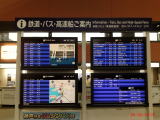
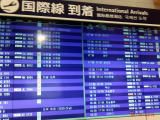
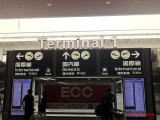
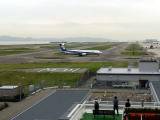
Notice ; From Kansai airport to Kobe, Wakayama, other areas in Kansai,
you can also utilize buses or taxis.
In particular, search the Internet for information, search words is Japan
Accessible Tourism Center.
Especially for Koyasan,Wakayama pref. ,we have a direct bus service to
Koyasan, though just one service a day.
※The direct bus transport : Information at a certain point. Please check
again by yourself.
From Kansai Airport To Koyasan : departure time(10:10am)/arrival(11:55am)/ the time required : about 2 hours
From Koyasan To Kansai Airport : departure time(1: 30pm)/arrival(3:15pm)/ the time required : about 2 hours
Suspended service : a period of consecutive national holidays<04/29~05/06>
and from December 1st to March 31st
One Round-trip daily/// Ticket sold in advance (online) : 1800yen / Same-day ticket: 2000yen(KIX: in the building/Koyasan: on
the bus), In particulars : Ask Kansai Airport Transportation Enterprise.
※REFERENCE / Taxi Fare : the starting fare : in general, 2km=730yen or
1km=410yen(might be supposed to alter into)
However, it depends on situation, company circumstances,or others.
![]()
![]()
EX.(1) ¶¶ Your hotel at Namba, Osaka city~Kansai Airport,Izumisano city: It takes about 1 hour by express train to Namba
Station. ( this train fare: 920 yen per one person /or, you can utilize
limited express trains: higher fare)
And, from Namba Station to your hotel (accommodations),within Namba AREA:
10 minutes ~30 minutes for
walking or by taxi. You can ask me about Japan or things needed through
your trip while moving.
☆For about two hours / pick-up service accompanied by small talk with me
for your travel : 8000yen(guide fee)+
transportation expenses including me+my expenses to Kansai Airport and
other expenses : 1500yen
○ Your total costs will mostly be 9500 +if two people , you and me, about
2000yen ,in total 11500yen depending on
your choice of transportations, such as trains or etc.
![]()
EX.(2) ¶ Other airports and etc.but Kansai Airport: please ask me about it by E-MAIL(FROM MY TOP-PAGE).
I will tell you whether it is possible or not, immediately.
EX(3) SPECIAL PLAN (NEW) : EX(1)PLAN + How about low-priced accomodations(lodgings)such as Internet Cafe or
capsule hotel with sauna baths ?
![]()
![]()
![]()
☆ The rates for Internet Cafe : 2000yen ~3500yen for about 10 hours depending on time zone or the day.
It might be higher price on Friday or Saturday depending on situations.
※ Mostly no reservation, in case, need reservation / It's sanitary,convenient and cozy.
You can utilize shower bath(additional charge ; 200~ 400yen),food service, Internet and free viewing of Magazines,
depending on shops or service owners. <food service for pay/free drinks
at that segment>
You can choose an individual room( a flat-cushion room or room with a
reclining chair) or larger room available
for special option,which is higher rates.
I guess it would be enough space to sleep at the standard individual room
if you are within 175㎝ tall.
There might be the day closed. Shall we check in advance !!
![]()
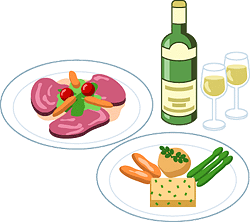
![]()
![]()
☆ The rates for capsule hotel : (just for men) 3500yen~ 4500yen for about 10hours depending on situations.
You can utilize food service at the restaurant room.
※ Usually no reservation, but we can make a resevation.
I guess it would be enough space to sleep at the individual capsule box,
though it is small, if you are within 180㎝ tall.
※ You can also check out for both types of lodgings before deciding where
to stay as the both I know well are located
at the same building in NAMBA .
☆ Let's enjoy Osaka until 9pm and then I will take you to one of these
lodgings and help you take your procedure to stay here.
This plan would be charged for my guest with guide fee (30000yen for 8
hours) , some transportation fees including me
and lodgings rates for you and me. Of course, if it is over 8 hours,
you can have a free time without me.
Let's decide a meeting place. After checking in the lodgings, my duty would
be finished, however, ask me what you would
like to know without guide fees, though we keep silent inside the building
and must keep the voice down.
I guess your trip expenses would be about 40000 or 50000 yen.
As tourist spots in the NAMBA vicinity,there are Osaka Castle, Bunraku
puppet play Theater,Dotonbori district for food
people spend much money on ; what is called Kuidaore in Japanese , large
shopping malls and large-scale electric
appliances stores. Besides, we can get UMEDA, northern Osaka City for 15
minutes on the train.
※ complete city transportation systems : subway (to the destination nearby
: 10~20 minute ride/about 230 ~300 yen )
depending on the distance or route // taxi or bus also available
![]()
#What is the place of Namba ? That is Southern Osaka city, located in South Ward, South Area in comparison with Umeda,
North Area. There are a lot of food, cuisines, culinary delights made by
superb skills, and OSAKA local specialty and others.
Some tourist spots are located in or close to Namba, such as Dotonbori,
Shinsaibashi, Bunraku theater, Yoshimoto comedy hall
, Water bus station of Yodo river(Okawa),and Osaka Castle. Notably, there
are the wide range of transportations such as,
municipal subways, JR, Nankai, Kintetsu and Hanshin railway, and highway
express buses extended across almost Japan.
They are the best to get your destination. Please check out on the Internet.
Namba is the KEY SPOT to many tourists.
Namba ~ (To Himeji, Kobe, other Sanyo areas) or (Kyoto or this direction)
or (Nara or this direction) or (Wakayama)
or (Kansai Airport) or (others)
☆ Nickname in Columbia Court 111,CA,theUSA.: Nakashi.
If you are my friend, please mail directly as my best friend.
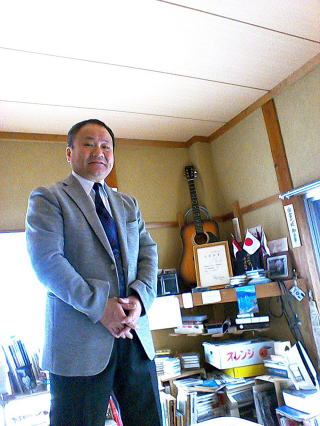
| ※ Introduction from Tadashi Nakamae Having lived in various parts of Kansai area, especially from the viewpoint of a member here, I would like nicely to tell you the whole image of Japan when I share your time so as to make a good memory. There are many places with Joyful and Exciting atmosphere,Koyasan,Wakayama City,of course ALL JAPAN. And also as a teacher of one of the biggest private schools in Japan, I will converse with you handily about full scale of the present, past and future of Japan using my knowledge of geography,history,etc. My guests will surely have a pleasant trip that is first safe enjoying our culture, such as beauty and the harmony. |
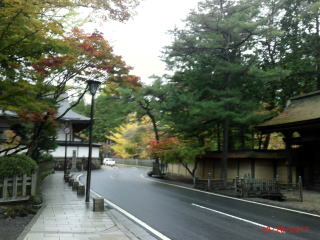
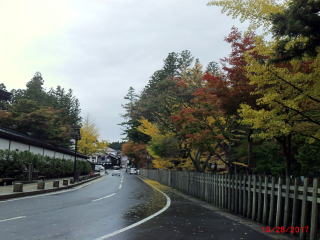
☆Koyasan main street(10/29,2017)
![]() Let's think. What is your preference? What do you want to see ?
Let's think. What is your preference? What do you want to see ?
※ This list is just a tip or hint for our plans, not contract or data for
making travel plans.
Therefore, items can be changed freely without notice.
A group
1 building &structure 2 temple&shrine 3 road 4 housing 5 nature 6
insect 7 literature 8 politics 9 history 10 culture
11 arcade 12 anime 13 panda 14 bookstore 15 science 16 tavern 17 restaurant & eatery 18 fashion
19 souvenir 20 art 21 culture experience & scientific experience
22 sports 23 trekking 24 trial for Japanese daily life
25 Chinese zodiac 26 Buddhist wrestler statues 27 Buddhist pagoda 28
SAKE 29 tea ceremony 30 perfume
31THE WAY of SAMURAI 32 Zen Buddhism 33 Sumo match 34 snow-covered folk
house with a steep roof 35 bridge
36 TOKUGAWA 37 Ninja(secret agent) 38 Kamakura 9 shoguns 39 bakery 40
dry goods store 41 start-of-the year meal
42 maple leaf & cherry blossoms 43 The Tale of Genji 44 Red-light
district(Maiko&Geiko) 45 Wakayama Castle
46 Tokyo Nihonbashi & Osaka Nipponbashi 47 about 1100 Nara deer 48
Hanging Gardens(Umeda,Osaka) 49 Ryujin peak
(Gomazan,1372m, the highest peak of Wakayama in Kii mountain range) CF ※Ryuujindake 1382m: stretch over Nara and
Wakayama 50 Nishijin-Ori (silk fabric and brocade)
51 Japanese old-fashioned measure of unit (go/shou/to/koku/pyou-hyou)
/ In case it's water,
1go=180grams, 1shou=10go=1.8kg, 10shou=1to=18kg, 1pyou=4to=72kg, 1koku=180
liters
NOW ! TO THINK ABOUT SPECIFIC GRAVITY, NOT WATER,THIS IS RICE. WEIGHT OF
WATER ×about 88 %= THAT OF RICE
It is said that 1Koku is the amount(volume) one samurai warrior eats of
rice in a year; about 150kg ~160kg .<6/9, amended>
※ RICE⇒ 1GO=180ml=about 160g , so if it is cooked, it becomes 2.2times
since it contains weight of water.Therefore,
1 go of rice makes 350g of boiled rice. As the rice itself in the rice bowl weighs 150 g , boiled rice made from 1 go of rice equals
two bowls of rice and extra.<6/9,clarified> In old days, local lords'powers
were shown by the unit of koku-volume.
Wakayama, Kishu (old name) had 550thousand koku;This means he could support 550 thousand samurais as simple estimation.
52 industry 53 medicine &Chinese medicine 54 nuclear power plant
55 Tokyo Olympics 56 aging society & elderly care
57 manga(comic) KONAN&KOCHIKAME & Japanese deregulation
58 AI 59 agriculture & farm 60 cruising 61 population & 47 local
governments 62 wedding ceremony 63 KIMONO
64 KitKat 65 residence 66 geology & topography 67 observatory &
lighthouse 68 landscape garden & stroll garden
69 museum (Takehisa Yumeji) 70 Tamori-san 71 Universal Studio Japan or
Tokyo Disney Resort 72 major electoronics
retailer(Joshin or YAMADA,etc) 73 pilgrimage 74 major island, Shikoku eighty-eight
places sacred place 75 Imperial Palace
76 Asakusa 77 Ryougoku Kokugikan 78 Taikokan Museum 79 Tokyo City View 80 Hamarikyu-teien 81 Roppongi Hills
82 Kabuki-cho 83 Kagurazaka&Kouraku-en 84 Shinjuku-Gyoen 85 Harajuku 86 monorail Yurikamome 87 Shimo-Kitazawa
88 Mt.Takao 89 Yokohama Archive History 90 Hayama Marina 91 Nikko 92 Sado
Kinzan 93 Machiya(traditional townhouse)
94 Nishijin Textile Center 95 Shisen-do 96 Shugaku-in Imperial Villa 97
Eikan-do 98 Sanzen-in 99 Enryaku-ji 100 Uji
B group
1 Myoshin-ji 2 Hikone Castle 3 Amano Hashidate 4 Naramachi 5 Kashihara-Jingu 6 Shirahama Onsen 7 Kuman Sanzan
8 Museum of Oriental Ceramics 9 Osaka Museum Of History 10 Hozen-ji Yokocho 11
Kamigata Ukiyo-e Museum
12 Shinsaibashi 13 Tenpouzan Ferris Wheel 14 Hiraizumi & Chuuson-ji 15
Kinosaki Onsen 16 Kobe City Museum
17 Weathercock House 18 Hakutsuru SAKE Brewery Museum 19 Arima Onsen 20
Kouraku-en 21 Okayama Castle
22 Kurashiki 24 Minou 25 Japan World Exposition, Osaka,1970 (venue) 26
Suita 27 Kansai University 28 Osaka University
29 Ryougoku, Asakusa,Odaiba⇒Water-bus 30 Takayama 31 Miyajima-Misen hiking 32
Murasaki-Shikibu 33 Matsuo-Bashou
34 Suzumushi=Hikaru-Genji=Reizen-In 35 Nobel Road 36 hot spring 37 mixed
bathing 38 Katsushika-Hokusai 39 Sanshou
40 Shichimi-Togarashi spice 41 KENDAMA 42 anime,comics: Kyojin-no-Hoshi 43
Sengiri-Daikon(finely sliced white radish)
41 billboard 42 Shin-Yokohama Ramen Museum 43 manhole lid 44 Bonsai (dwarf
potted tree) 45 Gyotaku(fish print)
46 Takoyaki (octopus dumplings) /Taiyaki (sea bream fish-shaped pancake filled with bean jam) 47 Yakushima-Mononokehime
48 Atomic Bomb Dome 49 Mushagaeshi (warrior-back stone wall) 50 chopstick 51
Izanagi&Izanami,NARUTO 52 Japanese
myth 53 thermos bottle(SUITOU) 54 bamboo work 55 GTO 56 RICE BALL(ONIGIRI) 57
traditional cityscape 58 JAL&ANA
59 SAMURAI 60 PUTTIN PURIN(pudding) 61 ICHIGO DAIFUKU(strawbelly ricecake) 62
yakult 63 Bitchuu Matsuyama Castle
64 Hokkairo 65 Nail Clipper 66 Razor 67 Kitchen Knife 68 Shirakawago 69
Furoshiki(wrapping cloth) 70 NMB&AKB 71 EG
72 Fugaku-Sanjurokkei 73 tattoo 74 Kureyonshinchan 75 Obakenokyutaro 76 Sazaesan 77 Godzilla 78 DORAEMON
79 ULTRAMAN 80 Tiger-Mask 81 Kamen(mask)rider 82 NHK annual contest on
TV program devided into male and female
popular singers on New Year's Eve 83 rice cooker 84 pachinko 85 Kobayashi
Issa 86 Mah-jongg 87 computer game
88 Washoku(Japanese cuisines)&umami 89 geta 90 Colonel Sanders doll's
tragedy & Doutonbori River & HANSHIN
91 Japanese wedding ceremony 92 sushi & wasabi 93 unagi-no-kabayaki
(grilled eel) & Sanshou(Japanese pepper)
94 KINDAI-MAGURO 95 organic farm 96 volcano & earthquake 97 Ikuta-Jinja
shrine 98 Kobe>Taira-no-Kiyomori
99 Wakayama Misato astronomical observatory 100 SHIMIZU Aragishima (for
best 100 terraced rice-fields selected)
C group
1Snoopy>Mirokunotaki falls 2 postage stamp 3 protected animal>Kishuu-ken 4
pollen 5 rice>Nanatsuboshi>Yumepirika
6 seven samurais>Kurosawa Akira 7 Sakabayashi >cedar>sacred tree 8
Shin-uchi = the highest ranked Rakugo story-teller
9 Senno Rikyuu>ground green tea 10 Nagano Oomachi >sacred place of
lovers 11 Ooi-gawa river>farmed eel
12 sea squirt(HOYA)=what is called,the sea-pineapple>vinegared food
in Tohoku area 13 giant skunk cabbage>Oze
14 Hakuhou(37) Taihou(32) 15 Kawana hotel 16 Musashi (Nanki) 17 Yunomine hot spring>Sasayuri 18 members of UN(193)
19 IMAI(DOTONBORI) white noodle in hot soup 20 global warming 21 environmental
destruction > plastic rubbish pollution
>Tomogashima tour > bad influence on sea- ecology>decreasing of fishes 22 one of the greatest smiles>Buddhist statue
of Chuuguuji temple 23 Sake (Nada,Fushimi, Saijyo) 23 Kyoto> Tsutaya,Chourakukan
24 Uji>Takuminoyakata=tea ceremony
25 Doutonbori>Takoume=the oldest Oden shop over 170 years 26 Osaka souvenirs>Doutonbori>Ichibirian 27
Ogurakombu
28 Ootora(kamaboko) 29 Mitaka-no-mori Ghibuli Museum 30 experiencing type of tour>sushi pressing, ninja~samurai,bonsai,
roofed pleasure boat(ex. in Wakayama,Tokyo Sumidagawa, or Kyoto Arashiyama,etc.)
31 Kyoto Miyakoodori 32 ekiben(boxed
lunch) 33 Kyoto's three greatest festivals 34 plural Buddhist pagoda(3,5,7,9,13,etc)
& Tahoutou pagoda 35 Kokugikan & Osaka
Furitsu Taiikukan>SUMO 36 No & Kabuki & Bunraku> THE CLASSIC
THEATER 37 Sake Beverage of Nada made in Nada,
Hyogo prefecture (Sake like man), Sake Beverage of Fushimi made in Fushimi,
Kyoto prefecture (Sake like woman),
Sake Beverage of Saijyo made in Saijyo, Hiroshima prefecture ⇒ the most well-known three of Sake of Japan
38 <one-yen coin>made in 1959 with the design selected from among
applicants/the design depicts young trees
39 one of literary prizes / Akutagawa prize ・・・the oldest winner (the age of 75), 156times conducted, 163 winners awarded
40 Takarazuka Revue since the year 1914 / 104th year for 2017, this year / five troupes : flower, moon, snow, star,cosmos
41 (1,3,7,13,17,23,27,33,37,43,47,50,100,=Buddhist memorial service) 42 Abeno-H 288m, SKY-T 634m, Yokohama-L 273m
Osaka-F 252m, Tsutenkaku 87.2m 43 (1koku=1ryo<currency in Edo period=?about
70thousand yen <nowadays>)
44 shogi Professionals: 300people/lovers: 20 million people 45 Todai-ji
(Japan/Korea/China/India) 46 Kongorikishi (69days)
47 Horyuuji 31.5m/Touji 55m/Konpon Daito 50m 48 ? NAOKI/AKUTAGAWA literature prize- 5000 applicants<200, preliminary
screening passing < winner (1~4) 49 Aso >active volcano >hotspring
>caldera = Kumamoto 50 Kawabata Yasunari /
Yukiguni = The snow country
51 Sumo>Meiji-jingu>ceremony>Kisenosato> first time in nineteen years=the 72th grandchampion of Japanese 52七夕
Tanabata>blue(green), red, yellow, white, black 53 Tokugawa Ienari (concubine/40
females) = 55 children 54 shogun tenure
(Ienari 50 years / Yoshimune 29 yeras) 56 La Nina (2004~8/2010), El Nino(2009/2014~6)
> greenhouse effect gas >
emission of methane gas >permafrost thaw - 25 times more effective than
carbon dioxide →global warming 57 Todai-ji
(らはつ snail-shaped hair knots : not 966 but 492 / 白毫 whorl of white hair
on the forehead of the Buddha: right turn
58 Okamoto Taro > Taiyo-no-to (Sun Tower) > Osaka Universal Exhibition (Expo.),Suita 59 Sumo ring (setting lines' distance)
=70 cm 60 Natsume Soseki/ Shoutoku Taishi / Ito Hirobumi/ Noguchi Hideyo/
Yamato Takerunomiko←1000 yen bill
61 Edo Five Routes (the five main highway)<Tokai-do road, Koshu-kaido,
Nikko-kaido, Nakasen-do, Oshu-kaido>
62 Kagoshima=the 34th national park (Amami Islands National park) 63 the Ogura Anthology of One Hundred Tanka-poem
by One Hundred Poets 64 Ryoma's SWORD (Mutsunokamiyoshiyuki) 65 Syncretism
of Buddhism and Shintoism
66 古事記 The Records of Ancient Matters / 日本書紀 The Chronicles of Japan 67 Returning holiday traffic of Japan
68 銭湯 public-bathhouse / in 1968=17999 places, in 2016=2625 places , now
reducing 69 female like politicians/
Kasuga-no-Tsubone, Keishou-in, Kita-no-mandokoro, Ohatsu, Yododono, Ogo, Atsuhime 70 Asakusa Omikuji 7 kinds=100
sheets 72 GOD/Hiruko-line → headquater of Ebisu shrines = Nishinomiya shrine,
Kotoshironushi line → headquater of Ebisu
shrines = Imamiya shrine 73 funeral 74 Obi(sash belt)/kimono 75 Midsummer
Day of the Ox/grilled eel in Kansai or Kanto
76 Cherry Blossom Viewing 77 SALT 78 The First Food of the Season 79 The Buddhist Altar 80 wrapping cloth/folding
paper 81The Seven Lucky Gods 82 The Equinoctial Week 83 Shinto style Weddings
(Osaka Tenmangu / Meiji Jingu)
84 Gunkanshima(Hashima)/S 34 (in 1959)-population= 5249people 85 Chion-in (hidden nail called 六葉/ mercury, gold)
86 Todai-ji (pillar 6×6 ) 87 tamamushinozushi (hinged double doors) 88
Kabuki (box lunch / Makunouchi / Inarizushi-sushi rice
wrapped in deep-fried bean curd) Kyoto Minamiza 89 theatrical art (words
derived from traditional art →Kuromaku/Makuhiki
/oozume/sashigane) 90 Okinoshima(Yamato dynasty/ the general public prohibited
from entering) 91 Ogasawara islands
(original evolution of life) 92 sacred straw rope 93 picture tablet of
a shrine/ good luck charm 94 Kiyomizu (gate & pigment)
three storied pagoda/ vermillion 95 music instrument with string (koto/shamisen)
96 bamboo flute (shakuhachi)
97 tea caddy/ silk wrapping cloth > the head family of a school 98 Ukiyoe
/ Suibokuga (India ink painting)
99 Ikebana (arranging flower) 100 taiko (traditional drum made of paper[but,usually
animal skin] on a round frame/Awa festival)
D group structure and the like group (Kyoto)
1Yasaka Jinja shrine(kirizuma-roof) 2 Entsuu Ji temple (scenic backdrop
garden) 3 Horinouchike/Choseian(teahouse/4.5mat)
4 Daiseiin<(houjou-garden) dry landscape garden like India Ink Painting
> 5 Kohouan-no-bousen<by Kobori Enshu>
6 Nishihonganji-no-Hiunkaku<Toyotomi Hideyoshi's residence> 7 Nishihonganji-north-No
stage 8 Sumiya(tatami room with
deties) 9 Yabunouchi-ke (En-An/tearoom) 10 Yabunouchi-ke (En-An/alley of
the tearoom) 11 Myouki-an(Taian-an/WABI
-TEA, by Sen-no-Rikyuu)
E group (Mie)
1Ise-jinguu (God of Japan/agriculture, torii: calendar of farm)
F group (Nara)
1Todai-ji (Niou-statue by Unkei and Kaikei: sending ki-spirit) 2 Todai-ji (Rushana Buddhist statue/magnificent cosmos on lotus
seat) 3 Kasuga-Taisha shrine (deer,wisteria) 4 Yakushi-ji Five storied
pagoda(mokoshi=pent roof below the true roof)
5 Toushoudai-ji (Senjukan-non statue) 6 Nara juvenile prison (Romanesque
architecture)
G group (Wakayama)
1 Kumano Sanzan/natural power (San=three,zan=mountain), god ←mountain,
cave, stone, sea. 2 Negoro-ji daitou/ Big pagoda
H group (Osaka)
1 Daimaru department store - Shinsaibashi(Art Deco style) 2 Daisen Burial
Mound (Key shaped)
I group (Shiga)
1 Hikone Castle (flat type of mountain castle)
J group (Hyogo)
1 Joudo-ji (Joudo-dou/Shakyamuni triad←giant and shining ) 2 Himeji Castle
(Tamon Tower, inner citadel, outer citadel)
3 [place: Kobe→Kita(North)-ward, Chuuou(Center)-ward, Nada-ward, Higashi(east)Nada-ward,
Hyogo-ward, Rokko, Sannomiya,
Motomachi] 4 Port Island, Ikutagawa shrine, Maya, Arima <onsen=spa>, Ijinkan (foreign residence) 5 Transportation
(JR,Hankyu,Hanshin,etc) 6 Seto Inland Sea National Park / Osaka Bay /
Kobe Port / Harbor Land / Meriken Park
7 Kikumasamune/Hakutsuru/Sawanotsuru/Ohara School Art Reference Building/Port Tower/Kobe Maritime Museum
/Fuchigami-ke Residence/ Suma Seaside Aquarium 8 cities near Kobe/Nishinomiya,Takarazuka,Ashiya,etc
9 Koshien baseball studium (Mecca of high-school baseball & Home ground
of Hanshin Tigers professional baseball team)
>>>>D~J group <Kansai Area>
K group Japanese history (The famous people of my choice)
(1) from the Yoyoi Period to the Heian Period
1Himiko 2 Shotokutaishi 3 Empress Suiko 4 Soga-no-Iruka 5 Emperor Tenji 6
Emperor Shoumu 7 Emperor Kanmu
8 Sakanoue-no-Tamuramaro 9 Fujiwara-no-Michinaga 10 Kukai 11 Saichou 12
Murasaki Shikibu 13 Sei shounagon
14 Taira-no-Kiyomori
(2) from the Kamakura Period to the Azuchi-Momoyama Period
1Minamoto-no-Yoritomo 2 Hojo Masako 3 Honen,Shinran,Nichiren 4 Hojo Yasutoki
/ Hojo Tokimune
5 Emperor Godaigo 6 Kusunoki Masashige 7 Ashikaga Takauji / Ashikaga Yoshimitsu 8
Takeda Shingen
9 Uesugi Kenshin 10 Date Masamune 11 Mori Motonari 12 Akechi Mitsuhide 13
Toyotomi Hideyoshi
14 Sen-no-Rikyu 15 Maeda Toshiie 16 Ishida Mitsunari 17 Sanada Yukimura 18
Takenaka Hanbe, Kuroda Kanbe
(3) from the Edo Period to the Showa Period
1 Tokugawa Ieyasu 2 Tokugawa Tunayoshi 3 Tokugawa Yoshimune 4 Matsuo Basho 5
Ihara Saikaku 6 Chikamatsu
Monzaemon 7 Katsushika Hokusai 8 Tokugawa Yoshinobu 9 Saigo Takamori 9
Itagaki Taisuke 10 Natsume Soseki
11 Higuchi Ichiyo 12 Noguchi Hideyo 13 Togo Heihachiro 14 Yosano Akiko 15
Yoshida shigeru 16 Emperor Showa
Chronology ① ~ ⑬ + (A) NOW EDITING. SORRY FOR THAT.
① Jomon period → ② Yayoi period → (A) Yamato period → ③ Nara period → ④ Heian period → ⑤ Kamakura period
→ ⑥ Period of the Northern and Southern Court → ⑦ Muromachi period (including the Period of the Warring States)
→ ⑧ Azuchi-Momoyama period → ⑨ Edo period → ⑩ Meiji period → ⑪ Taisho period → ⑫ Showa period →
⑬ Heisei period
① c/12000 B.C.~300B.C. ② c/ 300B.C.~300A.D. (A)c/ 300A.D.~710 ③ 710 ~794 ④ 794~1185 ⑤ 1185~ 1333
⑥ 1336~1392 ⑦ 1336~1573(1467~1568or1573or1590)
⑧ 1568 or 1573~1603 ⑨ 1603~1867 ⑩ 1868~1912 ⑪ 1912~1926 ⑫ 1926~1989
⑬ 1989~
※ Ancient times → Medieval period → Modern times → Modern era → The present
age
∽THE YEAR<ex. popular event>
① c/12000 B.C.~300B.C.<Cro-Magnon man ~ > ② c/ 300B.C.~300A.D.<First Punic War~the
start of Migration period>
(A)c/ 300A.D.~710 <Southern and Northern Dynasties in China~ Sui - > ③
710 ~794 <fall of the Visigothic Kingdom>
④ 794~1185 <Treaty of Mersen > ⑤ 1185~ 1333 <Third - Seventh Crusade ~ Divine
Comedy written by Dante>
⑥ 1336~1392 <Hanseatic League> ⑦ 1336~1573(1467~1568or1573or1590) <Battle of Nicopolis ~ Copernicus proposes
Heliocentrism> ⑧ 1568 or 1573~1603 <French Wars of Religion ~ Edict of Nantes > ⑨ 1603~1867 <Dutch East Company
founded ~ Alaska purchase> ⑩ 1868~1912 <Suez Canal opened ~ Republic of China >
⑪ 1912~1926 <World War 1> ⑫ 1926~1989 <Great Depression begins ~ fall of Berlin Wall>
⑬ 1989~ <Gulf War ~>
L group sick or medical sufferings
Please check before coming to Japan.
1 heat rash あせも 2 sensitive skin 3 bruises うちみ sprains 捻挫 4 stiff shoulders 5
neuralgia
6 eczema しっしん 7 frostbite しもやけ 8 hemorrhoids 9 poor circulation 冷え性 10
backpains 腰痛
11 rhematism 12 convalescence from fatigue 13 cracked skin ひび 14 chapped
skin あかぎれ
15 before and after childbirth 16 acne にきび 17 others
M group
1 kagura(sacred music and dance) 2 goju-no-to/gorinto 3 Wayo(the ancient
architecture style in Japan combined with in
China)/ Karayo (Zen style) 4 Buddha status (Nyorai/Bosatsu/ Myouou) 5
hands and legs positions used by religeous services
(seppoin/chiken-in/tenpourinin/midajoin/hokkaitein/kekkafuza/hankafuza) 6
tea garden (tsukubai,tobiishi,kakei/toro)
7 zazen /komuso(bonze)←mendicant Zen priest of the Fuke sect wearing sedge
hood and playing shakuhachi 8 shoujin-dish
(Buddhist meal) 9 Ikebana(arranging flower)=Nageire(slanting style), Moribana(upright
style) 10 kabuki(revolving platform,
platform for actor raising and lowering)/(kumadori=actor's makeup)/(kuroko=kabuki
assistant) 11storytelling show (manzai,
rakugo,kodan) 12 sumo [wrestler: topknot(mage), belt(mawashi)], [ring (dohyo)/roof (ooyane): shibusa(four coloured tassels)
represents four seasons. →west=white=fall, south=red=summer, east=green=spring,
north=black=winter], ceremonies [dohyoiri
yumitorishiki] 13 ceramics & porcelain 14 potter’s wheel / step-like kiln /Arita-yaki/Shigaraki/Kutani 15 Lacquered box
/Aizu,Tsugaru 16 kimono (furisode/tomesode//haori/hakama), broad sash(obi),
crest(mon) 17 footwear(zori,geta)
18 traditional craft (ukiyoe, dolls, bonsai, soroban, Nambu tekki ) Katsushika
Hokusai, Toshuusai Sharaku 19 folding fan (sensu)
20 Annual Event [the sun rise, shishimai, takoage(kite-flying), karutatori,
special new year's soup, toso(special sake), osechi dish
nanakusagayu(seven-herb rice porridge), kagami biraki(mochi offered to
God split open→zoni, shiruko made of it ), mamemaki,
yaikagashi/=oninometsuki (head of a sardine and leaves of holly skewered
to display), hinamatsuri, hanami, hanamatsuri, higan
tangonosekku(=children's day/musha ningyou, koinobori, chimaki <traditional
pastry>kashiwamochi<pastry, sweet adzuki bean
inside>), tanabata(sasakazari, okuri), mukaebi(welcoming fire), tanagyo(monk coming home), moon viewing, shichigosan(child's)
oseibo (year-end gift), toshikoshi soba, joya-no-kane(temple bell at midnight
sounded in a New Year's Eve), wedding(yuino,
kelp, abalone, cash, fan, linen thread, dried bonito,etc/nakoudo<go-between>/Buddhist
wedding,etc/oironaoshi at the reception)
funeral(tsuya, Nokan, dokyo, shoko, juzu<prayer beads>, koden<money
enveloped>, kotsuage<bones picked up>, salt, Nokotsu),
coming of age-day= the age of 20 <smoking, alcoholic,etc.>, long
life celebration (the age: 60, 70, 77, 80, 88, 99 etc)
good luck talisman<maneki neko(good business), daruma(wish), kumade(good
fortune), hama ya(exorcise), takara bune(treasure
boat), <inu hariko,etc>, animals in fables <kappa, ryu, tengu,
etc>, folk beliefs<jizo, dousojin(travel safety)in the town, kasa
jizou>,
old folktales<the peach boy, the return of the crane, etc>, 21Architectural
style (Shinmei-zukuri, Kasuga-zukuri, Taisha- , Hachi
man- , Nagare- , Gongen- ) 22 Ikebana (cutting/ trimming/ bending/ fixing)
23 Japanese Housing [Pit-style dwelling(Tateana)
<BC~around 6th century>, Shinden-zukuri (8th C. ~), Shoin-zukuri (15th C.~) 24 traditional games (Menko, Biidama,
Komamawashi, Tako-age/ Otedama, Ayatori, Origami/ Janken) 25 board games (Igo, shogi, Mah-jong) 26 Card Games (iroha
karuta, Hyakunin isshu, Hanafuda) 27 outdoor games [ Onigokko (tag), Kakurenbo
(hide-and-seek), Kankeri, Ishikeri, Nawatobi,
Kagefumi ] 27 Kimono (Kantoui, Karaginu, Hitoe, Mo, Uchikake, Kamishimo←historical / yukata, etc) 28 domestic travel [
Ryokan<futon(bedding)/ tanzen (gown)/Japanese cuisine>, hot springs,
another type→ones for drop-in visitors, bounty of the
sea, bounty of the mountains, craftwork, Hato-bus 29 professional baseball
⇔ high school baseball 30 martial arts
31 Wedding [yuinou (engagement) /gift → surume, suehiro, kombu, kinpou,
naganoshi, tomogashira/ Shinto,Christian or Buddhist
style/ wedding reception/ oironaoshi (bride's changing of clothes)-uchikake, furisode, western style dress/hikidemono (present
to guests from the couple] 32 Karaoke 33 Fukubukuro(lucky bags) 34 manga
kissa 35 Yakubarai (prayer at shrines against
the unlucky) 36 National character [ uchi or soto/ modesty and shame/ patience
and diligence/ giri and ninjyo ]
37 Tokugawa shogunate 4 giants: feudal lord Ii, Sakai, Honda, Sakakibara
58 secret agent Ninjya: Kouga and Iga / Hattori etc.
38 OOKAWA-YODO RIVER in Osaka> 30-koku boat/ Abeno harukasu 288m, Tsutenkaku
87.2m 31 Koyasan World heritage site
(Kongosanmaiin temple, Okunoin mausoleum, Tokugawa Reidai mausleum, Danjyo
garan <training place for monks>, Daimon gate,
Kongobuji head temple 32 Wakayama Castle ( Hidenaga Toyotomi)/ Sasutahiko
shrine (Yoshimune Tokugawa- guardian deity
of birthplace) 33 amusement arcade 34 Ienari Tokugawa (concubine 40 females,
55 children/ shogun tenure 50 years)/
Yoshimune's tenure: 29 years 56 Sumo (Nobunaga's rule/gyoji referee's sword・・・seppuku=hara-kiri,
Kakugo)
57 Chinese zodiac →十二(12)支=junishi (ne, ushi...)十(10)干=jikkan(kinoe,kinoto...),
a combination of 12 and 10→one round in 60
years/ 12支(twelve sign)=mouse, ox, tiger, hare, dragon, serpent, horse, sheep, monkey,
rooster, dog, and wild boar
10干(ten characters)=甲、乙、丙、丁、戊、巳、壬、癸、庚、辛 58 四度加行 59 Ibaragi pref. Hitachi seaside/
Nagano pref.
Karuizawa, Shiraito-falls/ Toyama pref. Kurobe dam, Tateyama/ Kyoto pref. Kitano Tenmangu, Koubai (red plum/H.5m)
60 sumo ring's directions/ four (blue, red, white, black) gods [ east:
blue(azure) dragon, south: vermillion bird of the southern
heaven, west: tiger, north: black tortoise ] 61 30 koku boat→ length 17m, wide 25m/loaded rice bag, 75hyou(5400kg×0.88)
1斗(to)=10升=18 liters/ 1pyo(hyou)=4斗=72kg(if water) 62 demon's gate direction: ushi (ox) tora (tiger)=northeast quarter &
counter direction: saru (monkey)tori (rooster)=southwest quarter 63 Todaiji
temple (Japan-Korea-China-India)/ Kongo
wrestler statues (69days) 64 the Sphynx / Mona Lisa/ Chuuguu-ji of Nara
pref. Buddhist statue → archaic smile
65 tea ceremony / sulfate paper for jelly dessert 66 IHATSUSODEN/ISSISODEN(衣鉢相伝/一子相伝)
67 Takenaka
carpenter's tools store (Shinkobe station to know architectural history 68
Daitoku-ji temple [Imperial envoy Gate/Tea master
Senno Rikyuu] 69 Kitanotenmangu (Kyoto), The sword: Minamoto no Mitsunaka,
founder of Genji of Settsu province 70
Buddhism from Kudara, Korea in 538 with fragrant wood(Koboku) such as
Byakudan, etc. 71 sumo wrestler ・・・Unryu or
Shiranui form 72 Sekigahara(of winter) War, Toyotomi: one hundred thousand
soldiers VS Tokugawa: two hundred thousand
73 new year's rice cake (kagamimochi)/decoration (kadomatsu)/ sake (otoso)
74 changing clothes (Koromogae)
75 the doll festival [ Emperor Doll, Empress Doll, Five Male Musicians,
etc] 76 Rooster Fair [ good luck charm] 77 Ox Day
78 Year-end Cleaning 79 The Last Bath after Death 79 The Twenty-four Solar
Term (24節気) 80 Furisode/ Tomesode
81 Obi (sash)[drum knot/ book-shaped knot/ shell's mouth knot/ fat sparrow
knot] 82 Hatsumono (seasonal food favorites)
83 seasonal gifts 84 Furoshiki 85 Dharma Doll 86 welcoming cat 87 lucky
direction (Ehou) for the year → eat maki sushi
88 six-day calendar system (六曜)= 先勝(senshou)、大安(taian)、etc. 89 old capital・・・Heijokyo
(Nara pref.) / Heiankyo(Kyoto)
90 Sakanoue tamuramaro 91the Picture Scroll of the Tale of Gen-ji 92 hair
style in Edo period: Chonmage
93 Christianity/Amakusa Shiro 94 Dog Shogun/ Tokugawa Tsunayoshi 95 revenge
incident in the peaceful Edo period/
Oishi Kuranosuke 96 classic literature from Osaka (old region name: Kamigata)
culture called Genroku (era name) culture
→ Ihara Saikaku and Chikamatsu Monzaemon 97 wood- block painting (Katsushika
Hokusai and Utagawa Hiroshige)
98 medicine in Edo-/Nagasaki pref. & Holland→Sugita Genpaku etc. 99
Sakamoto Ryoma (Kaientai: trading company)
100 Edo-jo (shogun) →< Tokugawa gave up. / The End of Edo > → the
Imperial Palace (from Meiji Period)
N group
1 Mountainous Japan 2 panoramic view of Kyoto/from Kiyomizudera temple 3
many tame deer/ Nara Park, Kasuga Shrine
4 Toshogu in Nikko<decorated shrine, pure water> 5 Ise-Shima in Mie <cultured pearls, jagged coastline> 6 Japanese garden
→not geometrical form but natural scene 7 dry landscape garden (Karesansui
type of gardens)→Ryoanji Temple
8 Yakimono・・glazed pottery⇔glazed porcelain 9 lacquered craft <design:
with gold and shell> 10 Nishijin<silk fabric>/ Yuzen
<dyed fabric> 11 sumo<origin: back over two thousand years/ as
a fortune-telling> 12 Buddhism<removing worldly sins or
desire> 13 shrine<gateway: torii/ mainhall: statue> 14 three great
festival of Kyoto (Aoi: 5/Gion: 7/Jidai: 10) 15 wedding rites
16 Japanese house<tatami room/zabuton (floor cushion)> 17 three famous
gardens (Kairakuen in Ibaragi/ Kenrokuen in Ishikawa
Korakuen in Okayama) 18 three scenic beauty (Matsushima in Miyagi/ Amanohashidate
in Kyoto/ Miyajima in Hiroshima)
19 Seven Queens in Japan <35th, Kogyoku/ 41th, Jito/ 43th, Genmei/ 44th,
Gensho/ 46, Koken (Shotoku)/ 109, Meisho/ 117
Gosakuramachi > 20 Mt.Fuji (3776m)/ Fuji on the back side, Yamanashi
pref./ Mt.Fuji on the front side, Shizuoka
21 cicum-Pacific volcanic belt 22 about 80 active valcanoes 23 many fast-flowing
rivers <Japan> 24 humid summer
25 The sunrise on New Year's holiday (Year-first sunrise: Hatsuhinde named
in Japanese) 26 New Year's food (Osechi)
26 Meharizushi (kind of sushi, local specialty) in Kumano region in Wakayama
<pickled Takana, leaf mustard used to wrap >
27 Shojin ryori: a type of vegetarian cuisine (vegetables, wild edible
plants, and soy food used) 28 fish used to make Japanese
cuisine (sardine/ horse mackerel/ mackerel/ salmon/ bonito/ tuna/ yellowtail/
young yellowtail/ flounder/ fatty tuna/ scallop
fatty tuna/ seabream/ conger eel/ sea urchin/ shrimp,prawn,lobster/ sea
cucumber/ salmon roe/ herring roe)
vegetables ( Japanese white radish/ Chinese cabbage/ burdock/ lotus root/ red beans/
green onion/ edible wild plants/bamboo
shoot ) fruit ( mandarine orange/ persimmon/ yuzu citrus/ Japanese UME plum ) SAKE, which is brewed from rice called
saka mai <koji and yeast added with water>/ Shochu, which is distilled liquor/ Ume liqueur// Japanese Tea (Hoji-cha<by
toasting coarse tea leaves >, Genmai-cha <blend of coarse tea leaves
and toasted rice>, Sen-cha<sweetness and fragrance>,
Gyokuro<top quality of green tea>, Matcha<tea of traditional tea
ceremony: finely ground>) 28 Shintoism followers (102million)
Buddhist followers(84 million) 29 Kojiki/Nihonshoki literature & Japanese
indigenous religion: Shintoism
30 Buddhism: by Siddhartha Gautama(566-486BC or 463-383BC)/-, which has
absorbed other religion and folk beliefs/
the same form→SHINTO (Amaterasu-Omikami, the goddess of Sun) = BUDDHISM
(Dainichi Nyorai , the Buddha of Greatest
Sun), 30 Komainu/ Torii (sacred world) 31 Shinto & nature 32 dragon/
deties of fire or water → wash basin 33 make a
donation → throw the yen coin gently and politely 34 purification of the
soul 35 the status into Buddha// Bosatsu; incomplete
(Bodhisattva)・・・[long hair with a crown/ gorgeous] → Nyorai; complete (Buddha)・・・[enlightenment/
simple robe; priesthood]
<Myo-oh deties (kind of police god) ・・・guide obstinate people to believe in Buddhism → scary faces/ ropes, etc in their hands>
<Ten; Indian deities incorporated into Buddhism/ guard gods of Buddha or Buddhism→ Some of them bear woman figures >
O group (Koyasan and Memo regarding Kukai )
(1) Besides Koyasan, he established Toji temple in Kyoto, which was given
him by the Imperial Court.
(2) He used advanced construction technology to repair reservoir called
Manno-ike and he completed the work in only 3 months
(3) He was a master of writing Kanji calligraphy, and was admired as one
of the best three masters of calligraphy in Japan.
(4) He has the posthumous title ''Kobo-Daishi '' and is revered by many
people. Now also, they call him ''Odaishi-San'' with
respect and so many thanks.
(5) He died at the age of 62. However, he is believed to be still alive
in Koyasan continuing to save people. Legend says his hair
has been growing longer inside the grave.
(6) Daimon: the entrance into Koyasan. It was built in 11th century, and reconstructed in 1705. Two statues were made and
placed in Edo period.
(7) Danjo Garan: important precincts, where he founded the Buddhist training
center and it consists of some halls,pagodas,etc.
(8) Sanko no Matsu: It has a legend. Buddhist tool thrown from China was caught onto the tree here, suitable place for his
temple, after flying away upon clouds.
(9) Kondo: main hall of the precinct/rebuilt six times/principal Image
= Yakushi Nyorai (10) Fudo-do: constructed in 1197/
12th century residence style/ Fudo-Myo-oh & attendant<Hachidaidoji>
(11) Konpon-Daito (pagoda): symbol of the Shingon
/Dainichi-Nyorai (12) Nyonin-do: no women were allowed to enter Koyasan
until 1872,Therefore they had to stay here for
prayers. (13) Kongo Sanmai-in: <National treasure→Tahotou Pagoda>/
built by Hojo Masako, the wife of Minamoto Yoritomo,
who is shogun, the first head of Samurai warriors class of Japan's history (15)
Kongobu-ji: the main temple of Koyasan/
headquarters of the Shingon Buddhism/ It has more than 3000 subordinate
temples all over Japan/ Its name comes from sutra
/reconstructed in 1863 (16) Kumano: ancient forests of Japanese cedars
and cypress, clear streams, and waterfalls/
Kumano Sanzan Shrine with Pilgrimage road <Buddhist paradise・・・ Hongu
Taisha, Hayatama Taisha, Nachi Taisha>
/World Heritage (17) Kumano Kodo: small shrines; Oji (the place of a god)
P group (Ninja/ secret agent)
(1) IN (fingers sign) (2) assassin or good servant (3) Tokugawa Ieyasu
& Hattori Hanzou (4) suddenly disappear
(5) receive self (6) not lose his head/ keep his head (7) 臨 兵 闘 者 皆 陣(陳) 烈 在/
九字法
(8) tool (weapon)→ shuriken/ shukou/ makibishi/ kokeshi/ kunai/ Hyakurai juu (9) breathing method 息長(Okinaga)
(10) Koga or Iga (11) Ninja food (兵糧丸→ もち米, うるち米, 蓮の実, やまいも, シナモン, はと麦,
高麗人参, 氷砂糖)
§ the Roman alphabet (Hepburn system)
※ - (hiragana katakana) / ( )
50 syllable order
文字 47+重複 3=50syllables
☆現在の日常文字(daily character)として 45(except ゐ、ゑ)+ん=46characters
| a (あ ア) i (い イ) u (う ウ) e (え エ) o (お オ) / ka (か カ) ki (き キ) ku (く ク) ke (け ケ) ko (こ コ) |
| sa (さ サ) shi (し シ) su (す ス) se (せ セ) so (そ ソ) / ta (た タ) chi (ち チ) tsu (つ ツ) te (て テ) to (と ト) |
| na (な ナ) ni (に ニ) nu (ぬヌ) ne (ね ネ) no (の ノ) / ha (は ハ) hi (ひ ヒ) fu (ふ フ) he (へ へ) ho (ほ ホ) |
| ma (ま マ) mi (み ミ) mu (む ム) me (め メ) mo (も モ) / ya (や ヤ) い(i) yu (ゆ ユ) え(e) yo (よ ヨ) |
| ra (ら ラ) ri (り リ) ru (る ル) re (れ レ) ro (ろ ロ) / wa (わ ワ) old ゐ(i) う(u) ゑ(e) を(o) / n (ん ン)←NOT SYLLABLE |
| ga (が ガ) gi (ぎ ギ) gu (ぐ グ) ge (げ ゲ) go (ご ゴ) / za (ざ ザ) ji (じ ジ) zu (ず ズ) ze (ぜ ゼ) zo (ぞ ゾ) |
| da (だ ダ) ji (じ ジ) zu (づ ヅ) ze (で デ) zo (ぞ ゾ) / ba (ば バ) bi (び ビ) bu (ぶ ブ) be (べ ベ) bo (ぼ ボ) |
| pa (ぱ パ) pi (ぴ ピ) pu (ぷ プ) pe (ぺ ペ) po (ぽ ポ) / |
¶ traditional Japanese character song using the above chart
いろはにほへと i ro ha ni ho he to /ちりぬるを chi ri nu ru wo(o) /よたれそつねな yo ta re
so tsu ne na
らむうゑのおくやま けふ こえて あさきゆめみし ゑにもせすん ra mu u e no o ku ya ma kefu ko e te
e ni mo se su n /

What food do you want to try?
Japanese naming of food
A group
1 sushi 2 tempura 3 okonomiyaki 4 tonkatsu 5 karaage 6 yakitori 7 kushikatsu 8
ramen 9 gyoza 10 curry rice
11yakiniku 12 teppanyaki 13 wagyuu 14 kani 15 mugimeshi 16 sukiyaki 17
shabushabu 18 kaiseki 19 natto 20 umeboshi
21 tendon 22 misokatsudon 23 unadon (unagi-donburi) 24 sukiyaki 25 nabemono 26
oden 27 okonomiyaki 28 shojin dish
B group
1 tororo 2 mozuku 3 namako 4 kujira 5 baniku 6 naizou 7 namaniku 8 namatamago 9
warabimochi 10 kanten
11 ebi-no-odori 12 awabi 13 sazae
C group
1 manju 2 dango 3 yokan 4 konpeito 5 taiyaki

What country is Japan ?
A (1) population: 126million 930thousand people (2) birth rate: 1.45 (3) the elderly aged 65 and over: 34million 610thousand
people ⇒ the rate for the general people: 27.3% <recordbreaking 2016> (4)
workforce: 64million330 thousand people
(5) unemployment: 1million880thousand people (6) unemployment rate: 2.8% (7)
the general accounting budget: 96trillion721
billion yen (8) exports: 77trillion yen / imports: 65trillion yen (9)
trading partner<export ranking in order>: 1 USA 2 CHINA
3 SOUTH KOREA 4 TAIWAN 5 HONGKONG / <import>1 CHINA 2 USA 3 AUSTRALIA 4
SOUTH KOREA 5 TAIWAN
(10) job-to-applicant rate: 1.45 times (11) individual financial assets:
1800 trillion yen (12) food self-sufficiency rate: 39%
(13) consumption tax 8%
B There are 47 local governments in Japan. The data for ranking top of the 47. ( )←per year/ yen
1 coffee consumption amount per month ; №1Tottori prefecture= 67cups(8126yen) 2
pasta per year ; Kyoto 27.2 dishes (1629)
3 bread per month ; Kyoto 27.8 bean- jam buns(converted )<40000yen annually>
4 icecream per month; Ishikawa 7.6 items
(10976yen) 5 sushi per month ; Ishikawa 17.9 dishes(23248yen) 6 cost for
coffee shop ; Gifu 5.7cups(17202yen)
7 cost for wedding ceremony per person; Chiba 4660000yen 8 rate or cost
for eating out ; Tokyo 22.9%(250000yen)
9 shotgun wedding ; Okinawa 38.2% 10 household of only the married couple
; Miyazaki 24.1%(108200)←over 60000 aged 65,over.
11 the number of divorce per 1000people ; Okinawa 2.53(3571) 12 active doctor per 100000 ;
Kyoto 308 doctors
13 spending for bus fare ; Nagasaki(9161yen) 14 spending for railway fare ; Tokyo(42771yen) 15 shop selling box-lunch
per100000people ; Kochi(23 shops) 16 100yen-shop per 100000people ; Kagoshima (5.82shops) 16 tavern per ten thousand
; Okinawa(11.7 places) 17 allowance of householder ; Kagawa 12316yen per
month /how about a child ? high school 5300 yen
junior 2500 yen 18 average savings ; Nara about 18million 19 child care
participation rate of men ; Tokushima 37.25%
20 public library per 100000people ; Yamanashi 6.4places 21 parental leave
availability ; Tokyo 14.7%<men>,82.8%<women>
22 museum per 100000 ; Nagano 5places (total 105places*also rank in top)//1087places
in Japan 23 diffusion rate of piano
; Yamanashi 34.8% 24 diffusion of dishwasher ; Fukui 39.7% 25 warm water
washing toilet seat ; Shiga 77.8% 26 sports engager
rate ; Tokyo 68.6% 27 gate-ball population per 1000 ; Shimane 28.6people 28
table tennis per 1000 ; Hyogo 39people
29 bowling population per 1000 ; Okinawa 146people 30 population in Edo period・・・entire country (30million people), Edo town
<150 thousand people in around 1600><one million 500 thousand
people in around 1800>
C Japan's 16 National Holidays (except substitute holiday)
* January 1st : New Year's Day * January (second Monday) : Coming-of-Age
Day * February 11th : National Foundation Day
* March 20th or 21st : Vernal Equinox Day * April 29th : Showa Day * May
3rd : Constitution Memorial Day * May 4th : Greenery Day
* May 5th : Children's Day * July (third Monday) : Marine Day * August 11th : Mountain Day
* September (third Monday) : Respect-for-theAged Day * September 23rd,
24th: Autumnal Equinox Day
* October (second Monday) : Health-Sports Day * November 3rd : Culture
Day * November 23rd : Labor Thanksgiving Day
* December 23rd : the Emperor's Birthday
☆Japan's climate; 7 points/ from north to south
rough estimate
Spring (March:3)/ Summer (June:6, August:8)
Autumn (September:9)/ Winter (December:12)
temperature / average; yearly
| month | 3 | 6 | 8 | 9 | 12 | average |
| Sapporo | 0℃ | 16℃ | 21℃ | 17℃ | -1℃ | 8℃ |
| Sendai | 4℃ | 18℃ | 24℃ | 20℃ | 4℃ | 12℃ |
| Tokyo | 9℃ | 22℃ | 27℃ | 23℃ | 8℃ | 16℃ |
| Kyoto | 8℃ | 22℃ | 28℃ | 23℃ | 7℃ | 15℃ |
| Hiroshima | 8℃ | 21℃ | 27℃ | 23℃ | 7℃ | 15℃ |
| Fukuoka | 10℃ | 22℃ | 28℃ | 24℃ | 8℃ | 16℃ |
| Naha | 18℃ | 26℃ | 28℃ | 27℃ | 18℃ | 22℃ |
| month | 3 | 6 | 8 | 9 | 12 | average |
| Sapporo | 32℉ | 61℉ | 70℉ | 63℉ | 30℉ | 46℉ |
| Sendai | 39℉ | 64℉ | 75℉ | 68℉ | 39℉ | 54℉ |
| Tokyo | 48℉ | 72℉ | 81℉ | 73℉ | 46℉ | 61℉ |
| Kyoto | 46℉ | 72℉ | 82℉ | 73℉ | 45℉ | 59℉ |
| Hiroshima | 46℉ | 70℉ | 81℉ | 73℉ | 45℉ | 59℉ |
| Fukuoka | 50℉ | 72℉ | 82℉ | 75℉ | 46℉ | 61℉ |
| Naha | 64℉ | 79℉ | 82℉ | 81℉ | 64℉ | 72℉ |
rainfall / mm / average; yearly
| month | 3 | 6 | 8 | 9 | 12 | average |
| Sapporo | 81 | 66 | 142 | 137 | 100 | 1129 |
| Sendai | 68 | 133 | 164 | 186 | 36 | 1204 |
| Tokyo | 100 | 185 | 148 | 180 | 46 | 1405 |
| Kyoto | 110 | 248 | 143 | 203 | 40 | 1581 |
| Hiroshima | 109 | 272 | 117 | 175 | 39 | 1555 |
| Fukuoka | 98 | 256 | 166 | 175 | 61 | 1604 |
| Naha | 162 | 253 | 259 | 168 | 123 | 2037 |
D 1 slippers / hangers/stocking/ cups → interesting boiled egg (using stocking) 2
a kind of mushroom(high price)→mattake
3 Japanese bazaar 4 eco-bag → furoshiki 5 thin paper (see tissue paper)
6 useful rice-cooker 7 Japanese spice
(SHICHIMITOGARASI/七味唐辛子) Use this when eating Udon noodle 8 hot spring
lodging (go to recover the health) Horses
and monkeys bathe in some spots 9 Japanese syllables (te/wo/ni/ha) made
mistakes even by Japanese
¶ My best selections of sightseeing spots, <April 8, 2016 MY NEWS> ○△UPDATES: according to requests of my
guest's.
 page ahead with pictures of sightseeing spots
page ahead with pictures of sightseeing spots
(also, the page linked with top-page album)
☆ I recommend that you should study Japan's information site for tourists,such
as by Government,prefectures,townhalls,
accommodations, or facilities and so on before or after seeing my web.
You would broaden some perspective how to
travel along with my web. Especially you can get maps and take a look at
various photos.
<Service B> Kyoto, Osaka, Nara, Himeji (Via Kobe) Model course
Model course ①~⑬ ![]()
![]()
this list/ update; July 9th, 2017
| ① Kinkakuji 金閣寺 in Kyoto; Zen sect Buddhist temple/The formation of this
temple was created by Ashikaga Yoshimitsu (足利義満), who was the third shogun
in Muromachi period (1338~1575). It is officially called Rokuonji. BEST SPOT; golden pavillion and large gardens with a pond, small Buddhist buildings BEST ITEMS; 舟形石 ship-shaped stone, 鏡湖池 strolling type of pond, 鐘楼 belfry, 陸舟の松 famous pine tree 銀河泉 the Galaxy spring, etc. |
| ② Ginkakuji 銀閣寺in Kyoto; Zen sect Buddhist temple/This was in origin constructed
by Ashikaga Yoshimasa(足利義政) as a villa on the mountain of eastside of
Kyoto. He is the 8th shogun of Muromachi shogunate. BEST SPOT; 東求堂Buddhist hall, 本堂 mainhall BEST ITEMS; 襖絵 paintings in the mainhall, 銀沙灘Ginshadan, 向月台Kogetsudai : white sand Mt.Fuji objects |
| ③ Sanjuusangendo 三十三間堂 in Kyoto; a Buddhist temple of the Tendai Sect/The official name is Renge-ou-in. The temple is full of Buddhist statues when you enter this building, the inner space of which is also very wide like the outward outlook is. |
| ④ Toudaiji 東大寺 in Nara; the center of Buddhism as well as that of cultural
activities in the 8th century, when Nara was the capital. TODAIJI was the general headquaters of all the temples across Japan.. BEST ITEMS; Kongorikisizou金剛力士像 : a pair of colored dry lacquered statues of the late Tempyo time, through the Nara period. , 四天王 4 Guardian Deities, 弁財天 Benzaiten & 吉祥天 Kichijouten & 地蔵 Jizou, 不動明王 Fudoumyouou & two attendant-boy Deities |
| ⑤ Kasugataisha 春日大社 in Nara; Kasuga shrine is Shinto shrine dedicated to
the so-called " 4 gods of Fujiwara". Fujiwara is the BIG NAME whose clan was influential in politics in Nara period. This shrine is founded at the present site in 768 , Nara period, according to the legend. |
| ⑥ OSAKA-JOU(castle) 大阪城 in Osaka; Actually this castle is the third OSAKA
CASTLE. Osaka castle founded by Toyotomi Hideyoshi, warring lord is the beginning of the OSAKA CASTLE. |
| ⑦ Kiyomizu-Dera(temple) 清水寺 in Kyoto; one of the oldest temple, its origin
dating back to the 8th century. The Hosso sect / the beginning is that in 778, late in Nara period, priest Enchin is believed to have built his hermitage and a chapel dedicated to Kannon deity, the origin of this temple. ※ vicinity: Gion 祇園 BEST ITEMS; Daikokutenzou 大黒天像 : the good-luck statue 113cm tall,Benkei’s (弁慶 who is a monk )belongings, 梟の手水鉢 Fukurou-no-chouzubachi : Owl water-basin, BEST SPOT; 音羽の滝 Otowa-Falls,清水の舞台 Kiyomizu-No-Butai : the grand terrace over the cliff |
| ⑧ Byoudouin 平等院 in Kyoto; If you have a ten-yen coin of Japan, please watch the side of the coin on which the building is depicted. This was first made as a villa of the aristcrats', Fujiwara, and later founded as Buddhist temple. Byoudoin is distinguished by the symmetrical building style called Shinden-zukuri Japanese style. ///spelling error <dukuri ×⇒zukuri ○// 5/23> |
| ⑨ Fushimi-inari shrine 伏見稲荷 in Kyoto; dedicated to the deity of fox, the
god of the harvest and industry. Notably in Japan, the whole mountain is enshrined with many small shrines. There are large shrine buildings at the gate of the mountain, famous for a great number of toriis (Shinto sacred arch) through the pilgrimage route, a barrier against evil spirit, normally one torii a shrine in Japan. |
| ⑩ Houryuu-ji (temple)法隆寺in Nara; the oldest wooden building in the world founded by Shotokutaishi 聖徳太子,who was a son of Emperor YOMEI. This temple has the most precious treasure of art in Japan such as buildings and others. It consists of two sections, east precincts and west precincts, surprisingly ranging pretty wide area. BEST SPOT; Chuumon Gate 中門: two storied gate, Kondou 金堂 : mainhall, Gojuu-no-tou 五重塔 : five storied pagoda, Koudou 講堂 : lecture hall, Yumedono 夢殿 : beautiful octagonal hall |
| ⑪ Himeji Castle 姫路城 in Himeji city, near Kobe, Hyogo ; Commonly called
“White Heron Castle”, the Himeji castle appeared in 1333 as a small castle
built by local warrior leader Akamatsu, atop a 46meters, 150 foot- high
hill called Mt. Hime, which means princess. That is here the beginning
of NATIONAL TREASURE ,Himeji Castle. BEST SPOT; Each gate for some segments 門, Ornamental tower (princess's make-up tower) 化粧櫓, Long corridor 百間廊下, Stone walls 城壁, Donjons in a large size and small size 大、小の天守閣 ○ Broadcast by NHK FULL-LENGTH HISTORY DRAMA, The Military Tactician Kanbei |
| ⑫ Ryouanji Temple 龍安寺 in Kyoto; Buddhist temple of the Myoushinji sub-sect
of the Rinzai sect. In 1450,Muromachi period, priest GITEN established
the temple under the patronage of HOSOKAWA KATSUMOTO, who was a top-ranking
warlord under the Ashikaga Shogunate, and also a pious devotee of the Zen
Buddhism. BEST SPOT; Sekitei 石庭=The rock garden, tsukubai and wabisuke tsubaki = A unique washbasin of stone (tsukubai) and Wabisuke camellia plant, Kyoyouchi Pond 鏡容池 |
| ⑬Nijo-jo 二条城 in Kyoto ; The castle was originally built in 1603 as the
official Kyoto residence of the first Tokugawa Shogun, Ieyasu for the
use of it on a special occasion in the Edo period. After the Meiji Restoration, it served for some time as the detatched Palace of the Imperial Household. BEST SPOT; Ninomaru Palace 二の丸御殿 : the inside of it = from the first building to the sixth building line-shaped slantwise. : あ Tozamurai 遠侍, い Sikidai 式台, う Ohiroma 大広間, え Sotetsu-no-ma 蘇鉄の間, お Kuro-Shoin 黒書院 か Shiroshoin 白書院. There are interestingly various functions for rooms of each building. |
jya→ja, jyu→ju, jyo→jo ※changed/ though how to use the Roman alphabet has three ways, and my top page says,
in this case, easier to read in the {→ ja} right side. therefore corrected.
※the list above : Of two alphabets used in Japanese / On this list: ( except
katakana, hiragana and Chinese characters called Kanji )
Hiragana and katakana are phonetic alphabets. There are 46 characters each.
(ex. あ, い,,は,,る → ア, イ,,ハ,,ル)
Kanji were imported from China. These are ideograms, which represent meanings.
(ex. 白書院)
Attractive tourist spots of my choices / contents below to add on later.
※ Now,let's go for amusement.
<OSAKA> AQUARIUM KAIYUKAN海遊館,DOTONBORI道頓堀, OSAKA-KURASI-NO-KONJYAKUKAN PAVILLION
大阪くらしの今昔館-That means livinghood in old town Osaka dating back to around
Edo,Meiji andTaisho period.
TSUTENKAKU 通天閣 & SHINSEKAI新世界, ABENO-HARUKASUあべのハルカス
<KYOTO>Tenryuji 天龍寺, Shimogamo Shrine 下鴨神社,Toji東寺,Nishiki Market 錦市場
Extra version 1
1 National Museum of Nature andScience/Tokyo 国立科学博物館 2 Meguro Parasitological
Museum/Tokyo 目黒寄生虫館
3 Hiroshima Peace Memorial Museum 広島平和記念資料館 4 Tokyo National Museum 東京国立博物館
5 Fukui Prefectual Dinosaur Museum 恐竜博物館 6 Mizuki Shigeru Memorial Museum
/Tottori pref. 水木しげる記念館
7 The Railway Museum/Saitama pref. 鉄道博物館
8 National Museum of Emerging Science and Innovation/Tokyo 日本科学未来館
9 Abashiri Prison Museum/Hokkaido 博物館網走監獄 10 Tokyo Metropolitan Art Museum
江戸東京博物館
11Exhibition and collection of Hobetsu Museum/ Mukawa Town, Hokkaido むかわ町立穂別博物館
12 Others
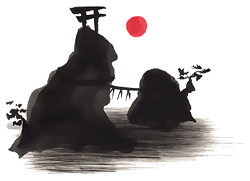
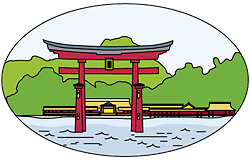
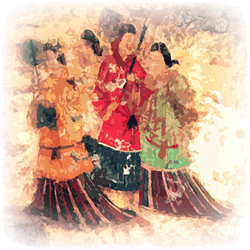
![]()
○ Why don't you enjoy your trip with me? You can make the choice out of the white list Model course①to⑬ above.
Model course plan A~J / (※ AS TO FEE&ALL INCLUSIVE in detail: see price setting above on this
page)
A ~J are combination plans, as are below.
<as part of guide transportation fee : Guide's cost to our meeting place
is 1200yen at NambaOSAKA/Total
amount, round trip Guide only needs means 2400 yen.> <At Kyoto/2000~2300yen
one way,Total is 4000~4600yen>
<Nara&Kobe/around the same amount as at Kyoto>
A- course plan/enjoy slow KYOTO-1=Choice①⑫plus the nearby area/need half day or one day.(※)
B- course plan/enjoy slow KYOTO-2=Choice②③⑦plus others/need half day(15.000yen within 3pl. plusα) or one
day(※)
C- course plan/enjoy slow KYOTO-3=Choice⑧⑨plus others/need half day or one day(※)
D- course plan/enjoy slow Nara-1=Choice④⑤plus others/need half day or one day(※)
E- course plan/enjoy quick Nara-1=Choice④⑤⑩plus others/need one day(30.000yen within 3 people plus αyen) (※)
F- course plan/enjoy quick KYOTO-1=Choice②③⑦⑬plus others/need one day(※)
G- course plan/enjoy quick KYOTO-2=Choice①⑫⑬plus others/need one day(※)
H- course plan/enjoy slow Osaka-1=Choice⑥plus others/need half day or one day(※)
I - course plan/enjoy slow Himeji-1=Choice ⑪plus others/need half day or one day(※)
J- course FREE PLAN=Choice OF YOUR OWN DOING
※ We can also make plans freely as you like it. Request it, please.
○ Depending on your starting point, we might have to change the schedule.
By request, I will arrange various combinations of travel plan. Please
contact.
| ○○ ( a brief summary of my career& personality) Born in Kansai area, graduated from major in economics of KANSAI UNIVERSITY, finished the intensive English course as a second language in UCI EXTENTION, the USA throuout one year(June1997~June1998), worked as a bank clerk in Namba Osaka,also worked as a juku teacher in Osaka,Kobe, Kyoto and Wakayama for from elementary school students to high school students ,learned English literature and Buddhism in Koyasan University as an unregistered student,auditor,worked for the family business, grocer merchant and palm rope manufacturer. ※Guide_intrpreter (Interpreter_guide) 通訳案内士 Qualification holders until the year 2014, I have won : just about 15000 in number / in English (my hobby);reading,studying,playing tennis,doing other sports,playing card game,watching TV,Sometimes go to some of theaters(BUNRAKU,KABUKI,CINEMA, MUSICAL), window-shopping, go to the library, occasionally listening to music, going to the museum and art museum.(music;I like Enka,sentimental ballad,anime song,pop,)(museum;UKIYOE) (the other qualifications I have): AED FOR medical emergency treatment, social welfare and care manager, ex-securities sales person,motor-bicycle or motor-cycle rider license [50cc~400cc],standard size of car driver license, ex-California driver license. (others); worked as a news boy,gas station clerk,examination sub-supervisor,and NHK TV PROGRAM MONITOR submitting reports, for psychological experiments at Osaka Unversity,for an assembly plant., as an assistant for arranging operating system of air conditioners, as a worker to make a concrete block. (personal history of my visit country);the USA. , Canada , Australia , India , Hongkong ,Thailand |
☆ Wakayama sightseeing plan
Wakayama Model course
(Model course plan A~P)
※ GUIDE FEE except A~O- Guide fee
( see price setting above on this page)
W①Koyasan高野山 :
| Introduction to Koyasan Koyasan is an alpine basin located about 1000meters above sea level. Surrounded by mountain peaks on all sides, it ranges 2.3Km by 5.5Km,north-south by east-west. It is a rectangular land. Kukai, known as Kobodaishi by his posthumous honorific name, sailed to China at the age of 31 in the year 804 to study Buddhism. After returning in 806, he had been spreading the Shingon Sect. He founded Koyasan as a religious,sacred place in 816, when the then emperor Saga granted him the land. Koyasan is a treasure house of esoteric Buddhism culture. |
○Model course 1,2,3,4
Could you enjoy sightseeing in Koyasan dividing into two main parts(GARAN伽藍1 +OKUNOIN奥の院2)
and two sub-parts(NYONINDO女人堂3 + ALONG MAIN STREET4) NAMED NUMBER 1,2,3or4.
> GARAN 1=EASTERN AREA, OKUNOIN 2=WESTERN AREA, NYONINDO 3=CENTRAL AREA
Why don't you enjoy your trip with me? You can make the choice out of 1to4
<as part of guide transportation fee in detail : Guide's cost to meeting
place is 500yen at Koyasan, one way
/Total amount, round trip means 1000 yen.>
A- course plan/enjoy slow Koya-1=Choice1 plus the nearby area/need three hours.(※guide fee 3750yen×3=11250yen)
B- course plan/enjoy slow Koya-2=Choice2 plus others/need four hours(※15000yen )
C- course plan/enjoy slow Koya-3=Choice3 plus others/need two hours(※7500yen)
D- course plan/enjoy slow Koya-4=Choice4 plus others/need three hours(※11250yen)
E- course plan/enjoy quick Koya-1,3=Choice1,3 plus the nearby area/need three hours(※11250yen).
F- course plan/enjoy quick Koya-2,4=Choice2,4 plus others/need four hours(※15000yen)
G- course plan/enjoy quick Koya-1,2=Choice1,2 plus others/need five hours(※18750yen)
H- course plan/enjoy quick Koya-2,3 /Choice2,3 plus others/need four hours(※15000yen)
I - course plan/enjoy quick Koya-1,4 /Choice1,4 plus others/need four hours(※15000yen)
J- course plan/enjoy quick Koya-1,2,3 /Choice1,2,3 plus others/need five hours(※18750yen)
K- course plan/enjoy quick Koya-1,2,3,4=Choice 1,2,3,4 plus others/need eight hours(※30000yen)
L- course plan/enjoy slow Koya-1,3,4=Choice 1,3,4 plus others/need one day,eight hours(※30000yen)
M-other course plans = We have one hour course(3750yen)
○ Depending on your starting point, we might have to change the schedule.
By request, I will arrange various combinations of travel plan. Please
contact.
W②Kudoyama 九度山 :
| Introduction to Kudoyama(Koyasan area) Koyasan area is designated as a world heritage site, including the temple Jison-in at KUDOYAMA TOWN, where Kukai's mother lived. Kudoyama was named after the fact Kukai visited his mother nine times a month. The word Kudo for nine times in Japanese is the same word expression ;i.e., kind of homophone(play on word) for the word Kudo indicated by Kudo-yama. There are local specialties and lots of samurai warriors' treasure handed down from old days. Visitors can also enjoy walking through the ancient track from Kudoyama to Koyasan, about 24km. It takes about 6hours. You would be able to taste the atomosphere of old days seeing the natural, artificial or other things derived from Buddhist legend and cultural activities in those days by your own foot. It would seduce you to get itchy feet. |
TRANSPORTATION/( Osaka) Namba~using Nankai railway,about one hour, Kudoyama station
Koyasan~using Nankai railway,about 40 minutes for only boarding hours , Kudoyama station
<as part of guide transportation fee in detail : Guide's cost(N or O
course) to a meeting place is 500yen at Koyasan, one
way/small amount, round trip means1000 yen> /after starting our course(the other fare①②) : ①Koyasan ~Kudoyama,
and② fare in case we go back to Koyasan //
※in case we go to Namba after enjoying Kudoyama,round trip cost Guide-only
needs is small amount 1000yen and
around1500,back to Koyasan( from Namba)・・・total for Guide-only transportation cost(which means when Guide
moves single) is around 2500 yen.
<In case a meeting place is at Namba, 1200 yen(to Namba)>/after starting
our course (the other fare①②):
①Namba ~Kudoyama, 790yen per person (by train as of April 2016) and②fare
in case we go back to Namba
/Guide-only round trip cost is 1200yen and 1200yen.>
※in case we go to Koyasan after enjoying Kudoyama,we need train fare from
Kudoyama to Koyasan.
Total for Guide-only transportation cost is 1200yen and 1500yen
※※If you enjoy going on a trip from Kudoyama on foot, remove the train
fare,from Kudoyama to Koyasan.
N-Kudoyama course plan = We need eight hours to walk from Kudoyama to Koyasan with related spots.(※40000yen
)
N,this course is what extra-fee is recquired, so that is 30000yen and 10000yen.
O-Kudoyama course plan = We need five hours to walk in Kudoyama Town enjoying some historic spots
such as shrine
and temples connected with Koyasan,andSanada-an,where Sanada,great warrior
in around 16th
~17th century lived. (※30000yen including moving hours)
SANADA FESTIVAL/ May 8th, 2016
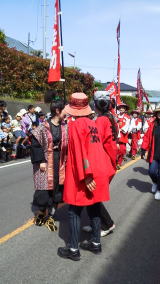
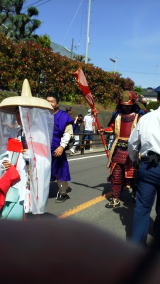
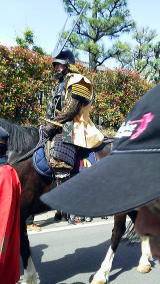
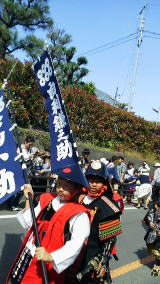
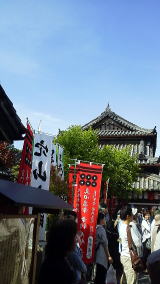
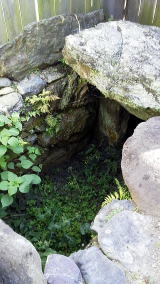
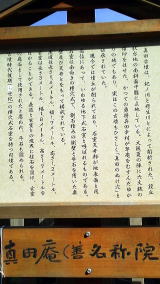
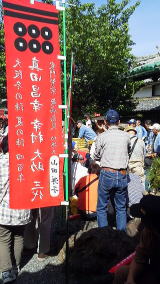
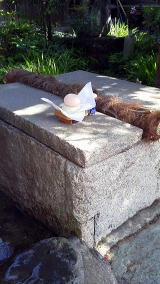
W③Taiji (太地) COURSE : EXTRA PLAN
P-Taiji (太地) course plan = WHALE AND DOLPHIN TOWN /How do you say to going to Taiji ?
※ Transpotation : From Kansai Airport To Taiji (It takes around 4 hours.)
Train route : Kansai Airport-Hineno-Wakayama-Taiji
Use express (rapid) train and limited express train. FARE : boarding ticket
fee+limited express fee (around6000yen)
It depends on time zone and other situations.
Just info. ※If you go with me, I might be able to get the ticket below. Please say
earlier to get. Mail me, and I'll tell in detail.
1 Takarazuka Revue (July, August) in Kansai 2 Kabuki (July) in Osaka 3
Myoshin-ji temple <special viewing & cuisine> (July)
cost : 5000 yen per one person
<Service C> Added ! I'm sorry to have kept you waiting so long.
Optional tourism
What would you think we will enjoy green tourism(taking a relaxed life
in a rural area), eco-tourism, or just going fishing ?
Besides, how is infra-tourism ? We can see construction sites and the inside of structures or creations with their technology
If you like it, mail me,please. Let's make a tour of these fun places.
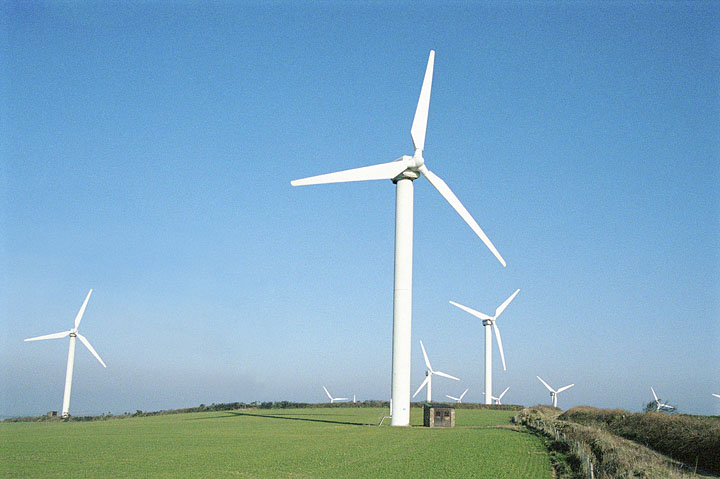
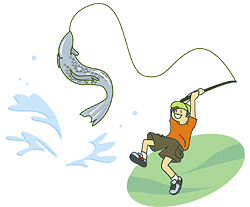
How about wondrous experience ?
PLEASE CHECK FOR ALL SERVICES.
↓
| ○ Depending on your starting point, we might have to change the schedule. By request, I will arrange various combinations of travel plan. Please contact. And, if my explanation on this web isn't clear, please ask me by way of e-mail. |
| ☆ Terms and conditions Taking out travel insurance is highly recommended before you come to Japan. I can't be liable for any damages during your tour, which may arise from causes beyond my control. Japan is a safe country, I will do my best to prevent accidents you may suffer, but please make sure your condition during your tour. Let's kick things off by making the form below. |
 Back to the toppage
Back to the toppage
World heritage site/
sacred place
KOYASAN ESTABLISHED
BY KUKAI 空海(弘法大師)
Welcome to Wakayama ! pictures below ; At Koyasan
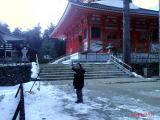
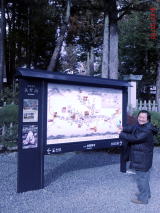
| Some of Brief Notes : To say Koyasan as a viewing spot, first, there is a Daimon at the west
point, which is an entrance building of Koyasan. It is flanked on each side inside this gate by the Kongo warrior statue which guards the mountain. Second, there is Okunoin at the east point, the very place sacred, solemn and tranquil. You will reach Kobodaishi's mausoleum. Along the cemetery path, there are many tombs for well-known figures in history such as warlord,Tokugawa, Toyotomi and Oda,poet,and so many other celebrities, commoners as well through Japan's long history. Third, there is Reihokan museum at the point of central area. It has a lot of cultural properties such as picture, clothes and calligraphy. Kukai is especially a master of writing, who is one of Three Great Brushes in Heian period. His works are displayed in this art museum. Fourth, in the same area to it across some blocks,there are Konpondaito pagoda and Kongobuji temple. This temple is the head of Shingon esoteric Buddhism, and that pagoda is the Daito,or Great Pagoda planned by KoboDaishi as the center of his monastic complex . ※Koyasan cho-ishi michi (高野山町石道) used to the main route to Koyasan It starts from Jison-in Temple in Kudoyama and leads directly to the main entrance to Koyasan,DAIMON Originally wooden stupas were installed along the route as signposts when Kukai founded this mountain in the 9th century. Later, stone markers took the place of the originals in the 13th century. They were created in the shape of Gorinto as the stonemarker were installed at every cho (109meters). They are called “cho-ishi”. ※Gorinto(五輪塔) 空 風 火 水 地 Gorinto is a five-story pagoda which consists of five pieces ; square,circular, triangle, semicircular and a flame-wreathed gem. Each one of them represents Earth, Water, Fire, Wind, Space. They are the five elements of the Universe in Buddhism, and each character is engraved on each of the five pieces in Sanskrit. The Gorinto has been the religious symbol of Koyasan. Many of them can be seen in Okunoin. |